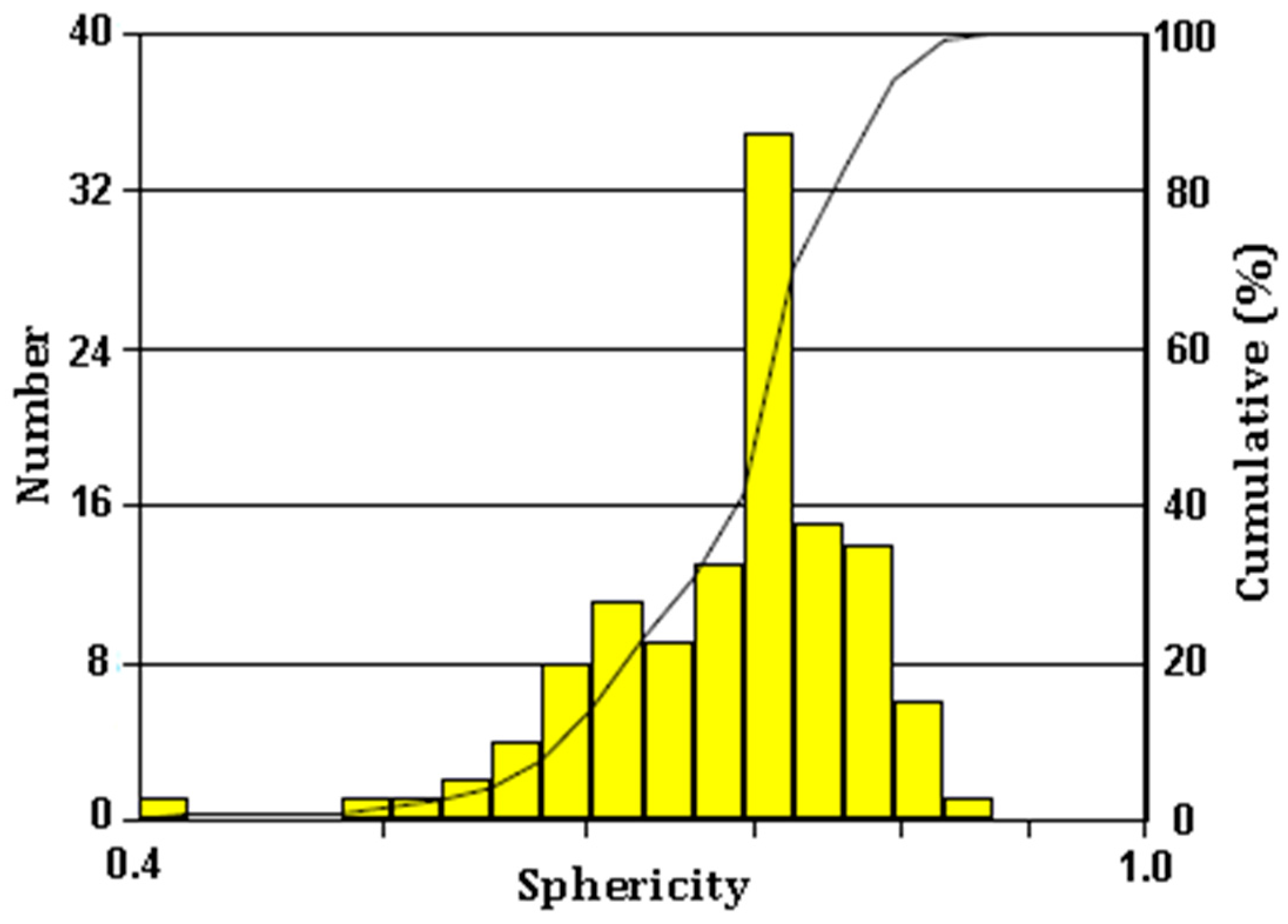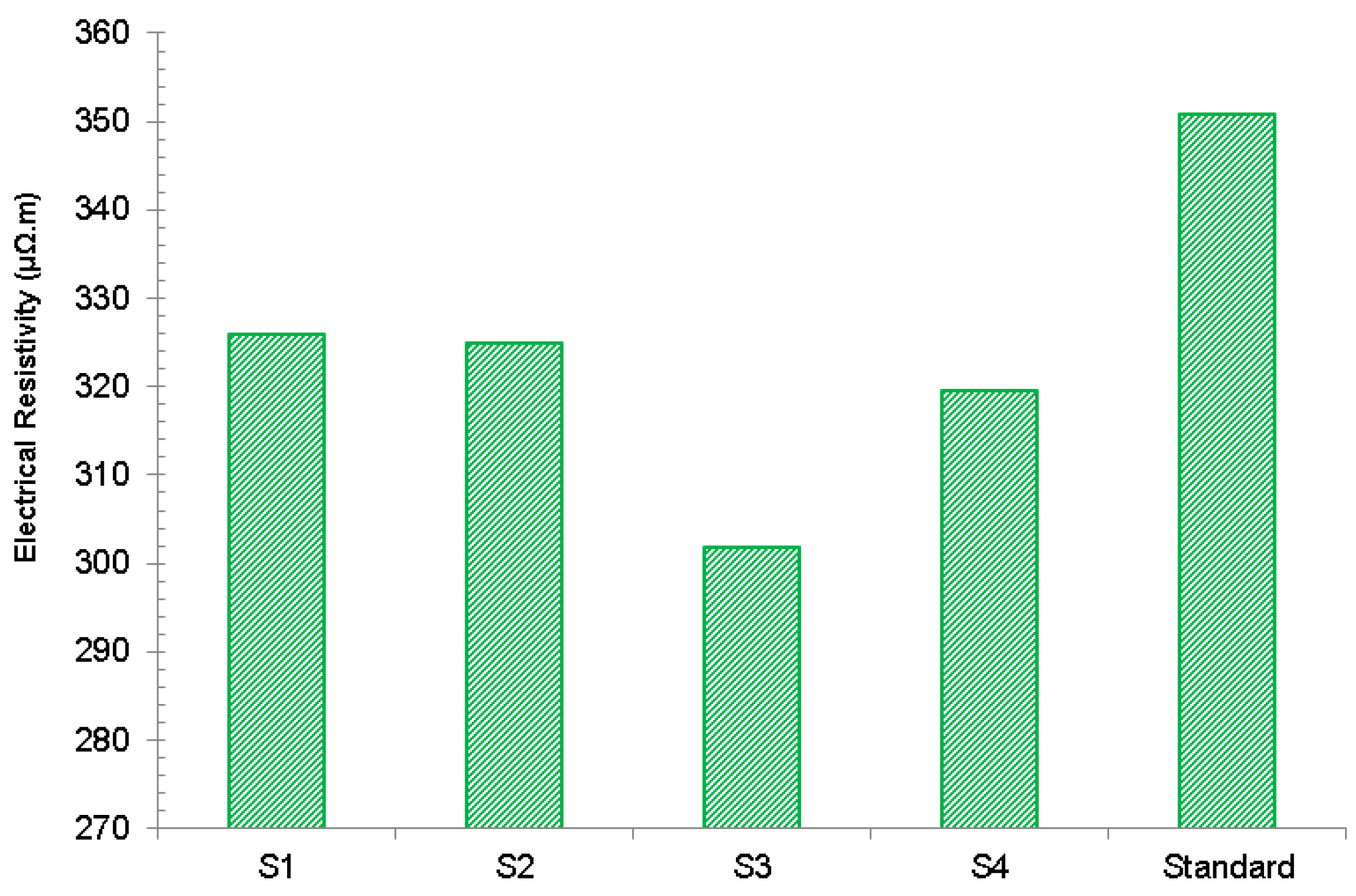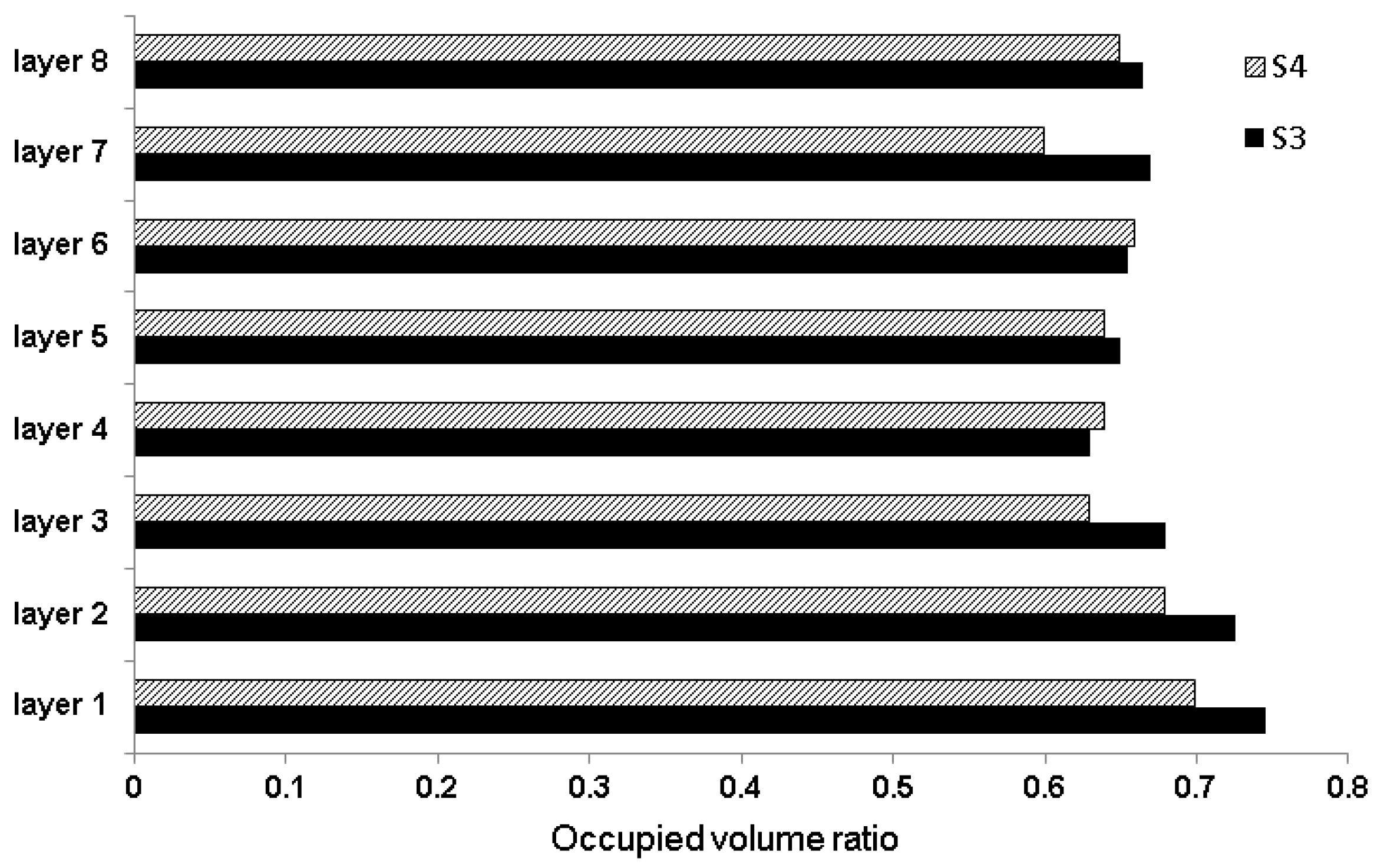Discrete Element Method Investigation of Bulk Density and Electrical Resistivity of Calcined Coke Mixes
Abstract
:1. Introduction
2. Numerical Model
3. Experimental Procedure
4. Results and Discussion
4.1. Vibrated Bulk Density
4.2. Electrical Resistivity
5. Conclusions
- Three-dimensional imaging was used to capture the shape and size distribution of coke aggregates. Modeled coke aggregates were used to investigate the packing density and electrical resistivity of coke particle mixes by means of the DEM.
- Determining the pore size distribution in the sample with only coarse particles was performed by void tracking on the numerical model of S5.
- An industrial aggregate recipe of coke aggregates for making anode paste was then modified according to the results of the void tracking. The modified recipes have a higher concentration of coarse particles and fewer fine particles, but their VBD is comparable to the standard sample.
- The electrical resistivities of the samples were also measured. Results showed that modified recipes not only provide a comparable or better bulk density, but they have a smaller electrical resistivity as well. DEM investigations on inter-particle contacts show that reducing the amount of fine particles decreases the contact density and increases the average contact radius within the sample. These two effects, if the bulk density is not compromised, result in a lower electrical resistivity.
- Since inter-particle contacts act as resistors, to obtain the minimum electrical resistivity in a granular system, one would need to decrease the contact density. On the other hand, having a higher packing density in a sample provides a greater area for current transfer in a given sample. This, as Ohm’s equation suggests, results in lower electrical resistivity. A single-piece chunk of material (with no contacts inside) would have the lowest electrical resistivity. However, if the material is in granular form, keeping the packing density as high as possible while minimizing the contact density contributes to having the lowest electrical resistivity.
Acknowledgments
Author Contributions
Conflicts of Interest
References
- Bernal, J.D. The Geometry of the Structure of Liquids. In Liquids: Structure, Properties, Solid Interactions; Hughel, T.J., Ed.; Elsevier: New York, NY, USA, 1965. [Google Scholar]
- Torquato, S.; Stillinger, F.H. Jammed hard-particle packings: From Kepler to Bernal and beyond. Rev. Mod. Phys. 2010, 82, 2633–2672. [Google Scholar] [CrossRef]
- Bourbatache, K.; Guessasma, M.; Bellenger, E.; Bourny, V.; Tekaya, A. Discrete modelling of electrical transfer in multi-contact systems. Granul. Matter 2012, 14, 1–10. [Google Scholar] [CrossRef]
- Mannweiler, U. Influence of raw materials on the properties of prebaked anodes and their behavior in Hall-Heroult cells. In Proceedings of the International Conference of Scientific and Technological Progress in Metallurgy of Light Metals, Leningrad, Soviet Socialist Republics, 17–19 September 1991. [Google Scholar]
- Azari, K.; Alamdari, H.; Ziegler, D.; Fafard, M. Influence of coke particle characteristics on the compaction properties of carbon paste material. Powder Technol. 2014, 257, 132–140. [Google Scholar] [CrossRef]
- Chevarin, F. Relation entre les Propriétés Physico-Chimiques de l’Anode en Carbone et sa Vitesse de Réaction sous CO2. Ph.D. Thesis, Université Laval, Ville de Québec, QC, Canada, 2016. [Google Scholar]
- Coste, B.; Schneider, J.P. Influence of Coke Real Density on Anode Reactivity Consequence on Anode Baking. Essent. Read. Light Met. 2013, 84–92. [Google Scholar]
- Hulse, K.L. Anode Manufacture Raw Materials Formulation and Processing Parameters, 1st ed.; R&D Carbon Ltd.: Sierre, Switzerland, 2000. [Google Scholar]
- Majidi, B.; Azari, K.; Alamdari, H.; Fafard, M.; Ziegler, D. Simulation of vibrated bulk density of anode-grade coke particles using discrete element method. Powder Technol. 2014, 261, 154–160. [Google Scholar] [CrossRef]
- Majidi, B.; Azari, K.; Alamdari, H.; Fafard, M.; Ziegler, D. Discrete Element Method Applied to the Vibration Process of Coke Particles. In Light Metals 2012; John Wiley & Sons: Hoboken, NJ, USA, 2012; pp. 1273–1277. [Google Scholar]
- Langston, P.; Kennedy, A.R.; Constantin, H. Discrete element modelling of flexible fibre packing. Comput. Mater. Sci. 2015, 96, 108–116. [Google Scholar] [CrossRef]
- Majidi, B.; Melo, J.; Fafard, M.; Ziegler, D.; Alamdari, H. Packing density of irregular shape particles: DEM simulations applied to anode-grade coke aggregates. Adv. Powder Technol. 2015, 26, 1256–1262. [Google Scholar] [CrossRef]
- O’Sullivan, C. Particulate Discrete Element Modelling: A Geomechanics Perspective; Applied Geotechnics; Spon Press/Taylor & Francis: Abingdon, UK, 2011; Volume 4, p. 103. [Google Scholar]
- Azari, K.; Majidi, B.; Alamdari, H.; Ziegler, D.; Fafard, M. Characterization of Homogeneity of Green Anodes through X-ray Tomography and Image Analysis. In Light Metals 2014; John Wiley & Sons: Hoboken, NJ, USA, 2014; pp. 1141–1146. [Google Scholar]
- Eidem, P.A.; Runde, M.; Tangstad, M.; Bakken, J.A.; Zhou, Z.Y.; Yu, A.B. Effect of contact resistance on bulk resistivity of dry coke beds. Metall. Mater. Trans. B 2009, 40, 388–396. [Google Scholar] [CrossRef]







| Size Range (Mesh) | Size Range (mm) | Content (wt. %) |
|---|---|---|
| −4+8 | 2.38–4.76 | 33.6 |
| −8+14 | 1.41–2.38 | 15.3 |
| −14+30 | 0.595–1.14 | 17.7 |
| −30+50 | 0.297–0.595 | 19.4 |
| −50+100 | 0.149–0.297 | 13.9 |
| Size Range (Mesh) | Apparent Density (g/cm3) |
|---|---|
| −4+8 | 1.377 |
| −8+14 | 1.532 |
| −14+30 | 1.524 |
| −30+50 | 1.586 |
| −50+100 | 1.586 |
| Size Range of Filling Spheres (Mesh) | Mass of Filling Spheres (g) |
|---|---|
| −8+14 | 0.07887 |
| −14+30 | 1.448 |
| −30+50 | 1.413 |
| −50+100 | 1.288 |
| Size Range (Mesh) | Size Range (mm) | Sample | |||||
|---|---|---|---|---|---|---|---|
| S1 | S2 | S3 | S4 | S5 | Standard | ||
| −4+8 Mesh | 2.38–4.76 | 60 | 60 | 60 | 65 | 100 | 33.6 |
| −8+14 Mesh | 1.41–2.38 | 0 | 0 | 0 | 0 | 0 | 15.3 |
| −14+30 Mesh | 0.595–1.14 | 15 | 20 | 15 | 15 | 0 | 17.7 |
| −30+50 Mesh | 0.297–0.595 | 15 | 10 | 10 | 15 | 0 | 19.4 |
| −50+100 Mesh | 0.149–0.297 | 10 | 10 | 15 | 5 | 0 | 13.9 |
| VBD (g/cm3) | 0.956 | 0.952 | 0.985 | 0.926 | 0.786 | 0.955 | |
© 2017 by the authors. Licensee MDPI, Basel, Switzerland. This article is an open access article distributed under the terms and conditions of the Creative Commons Attribution (CC BY) license (http://creativecommons.org/licenses/by/4.0/).
Share and Cite
Majidi, B.; Rouget, G.; Fafard, M.; Ziegler, D.; Alamdari, H. Discrete Element Method Investigation of Bulk Density and Electrical Resistivity of Calcined Coke Mixes. Metals 2017, 7, 154. https://doi.org/10.3390/met7050154
Majidi B, Rouget G, Fafard M, Ziegler D, Alamdari H. Discrete Element Method Investigation of Bulk Density and Electrical Resistivity of Calcined Coke Mixes. Metals. 2017; 7(5):154. https://doi.org/10.3390/met7050154
Chicago/Turabian StyleMajidi, Behzad, Geoffroy Rouget, Mario Fafard, Donald Ziegler, and Houshang Alamdari. 2017. "Discrete Element Method Investigation of Bulk Density and Electrical Resistivity of Calcined Coke Mixes" Metals 7, no. 5: 154. https://doi.org/10.3390/met7050154





